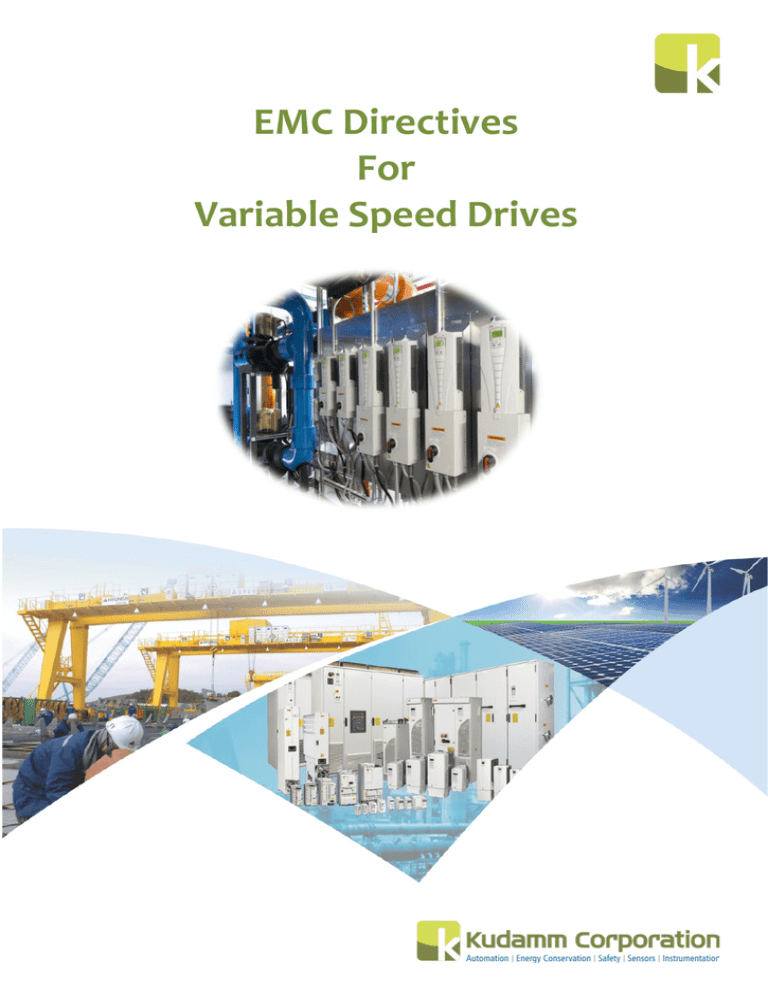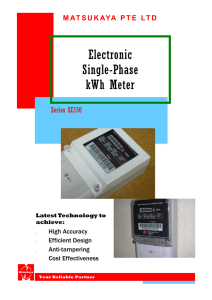EMC Directives For Variable Speed Drives
advertisement

EMC Directives For Variable Speed Drives Introduction to IEC The International Electrotechanical Commission (IEC), founded in 1906, is the world’s leading organization that prepares and publishes International Standards for all electrical, electronic and0 related technologies. The IEC is one of three global sister organizations (IEC, ISO, ITU) that develop International Standards for the world. A vast range of technologies is covered by IEC from power generation, transmission and distribution to home appliances and office equipment, semiconductors, fiber optics, batteries, solar energy, nanotechnology and marine energy as well as many others. IEC Standard 61800-3:2007 IEC 61800-3:2007 specifies requirements for electromagnetic compatibility (EMC) standard for PDS - Power Drive Systems with AC or DC motors. The Power drive system consists of a motor and Complete Drive Module (CDM). The CDM consists of a Basic Drive Module (BDM) & its possible extensions such as a feeding section or some auxiliaries. (See Figure below) INSTALLATION or part of installation POWER DRIVE SYSTEM COMPLETE DRIVE MODULE System control & sequencing Basic drive module (BDM) Control, converter & protection Feeding section Field supply, dynamic braking Auxiliaries, others… MOTOR AND SENSORS DRIVEN EQUIPMENT Figure: Definition of the installation & its content IEC 61800 is specifically meant for variable speed drives & talks of all matters, limits & testing related to variable speed drives. Since it is VFD specific, It takes into account, the problems created by latest generation VFDs where the IGBT switching time varies from 100 to 200 nano seconds and dV/dt requirements of IGBTs can be greater than 1000 Volt/micro second. All issues like conducted and radiated emission, harmonics emission (low frequency disturbance), commutation notches, voltage fluctuations ,phase fluctuations, unbalance voltages ,dips and short interruptions, magnetic and capacitive coupling are dealt with. Also covered is the harmonic current emission requirement relative to the total current of the agreed power at the PCC (Point of common coupling) which is another standard IEEE -519. Also touches upon system EMC: The objective of system EMC analysis means to assist in the development of design requirements and procedure to ensure the drive system meet EMC requirements. IEC 61800-3 covers all aspects of EMC generation and mitigation technique specifically related to Power Drive System. IEC 61800-3 has two installation environment I. II. First environment Second environment Public low voltage network Industrial low voltage network nd Point of measurement for 2 environment equipment PDS Point of measurement for st conducted emission 1 environment equipment PDS Equipment PDS Figure: Illustration of environment classes First Environment The first environment includes domestic premises. It also includes establishments directly connected without intermediate transformer to a low-voltage power supply network which supplies buildings used for domestic purposes. They are suitable for the EMC environments described by the typical standards for this type of environment. Second Environment The second environment includes all establishments other than those directly connected to a low-voltage power supply network which supplies buildings used for domestic purposes. EMC EMISSION LIMITS The product standard IEC 61800-3 divides PDSs into four categories according to the intended use. PDS of category C1 A PDS (or CDM) with rated voltage less than 1000 V and intended for use in the first environment Category C1 Household appliances Usually plug connectable to wall outlet Example: TV sets, computers microwave ovens etc. PDS of category C2 A PDS (or CDM/BDM) with rated voltage less than 1,000 V, which is neither a plug in device nor a movable device and is intended to be installed and commissioned only by a professional. PDS of category C3 A PDS (or CDM/BDM) with rated voltage less than 1,000 V, intended for use in the second environment. PDS of category C4 A PDS (or CDM/BDM) with rated voltage equal to or above 1,000 V, or rated current equal to or above 400 A, or intended for use in complex systems in the second environment. In applications related to C4 category equipments the EMC plan to meet the EMC requirement of the intended applications are to be agreed upon where in the user defines the EMC characteristics of the environment including the whole installation and the neighborhood. The manufacturer’s liability is to provide the information on typical emission levels of the PDS which is to be installed. Standard EN-55011 EN 55011 is a product standard for industrial scientific & medical equipments(ISM) which generate and or use local radio frequency energy for industrial, scientific, medical or similar purposes excluding applications in the field of telecommunication and IT. It separates all equipment in two groups: Group 1 & Group 2, each group is further subdivided into two classes Class A & Class B. Group 1: ISM (industrial scientific & medical equipment) contains all ISM equipment in which there is intentionally generated and/or used conductively coupled radio-frequency energy which is necessary for the internal functioning of the equipment itself. Group 2: ISM (industrial scientific & medical equipment) equipment contains all ISM equipment in which radio-frequency energy is intentionally generated and/or used in the form of electromagnetic radiation for the treatment of material, and EDM and arc welding equipment. Class A: Covers devices for usage in all establishments other than domestic and that are not directly connected to a low voltage power supply network which supplies domestic environment. Class B: Covers devices for usage in domestic establishment that are directly connected to a low power supply network which supplies domestic environment. Both standards are comparable with reference to limits as shown below. Table: Comparison of standards


